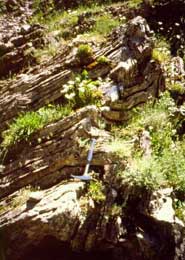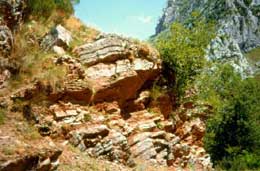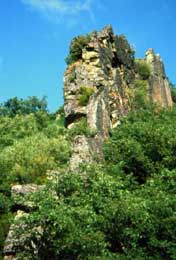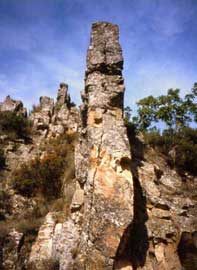Geologyé çGeological History Western Massifè General Stratigraphy of the Western MassifVega Huerta - Carbanal FormationEraStephanium Carboniferous Kasimovian Age DescriptionWith a minimum thickness of 200 m, this unit is made up of a series of black and grey, thinly bedded, bioclastic limestones and shales with olistostromes Picos de Europa Formation - Upper MemberEraWestphalian Carboniferous Moscovian Age Upper - Myachkovskian Middle - Podolskian Lower - Kashirskian DescriptionResting on red crinoidal limestones of a few metres, this 500 m high member is made up of massive, white and fossiliferous limestones with pink coloration that becomes more frequent higher up. Picos de Europa Formation - Lower MemberEraWestphalian Carboniferous Moscovian Age Vereiskian DescriptionFormed by about 150 m of dark, thinly bedded bioclastic limestones, that alternate with abundant chert and shale levels. Caliza de Montaña - Valdteja FormationEraNamurian Carboniferous Bashkirian Age DescriptionMassive grey limestones, sometimes with fossils. Beds may include macrofauna and seaweed, or more frequently, microfauna. Depositional EnvironmentThis series formed as local carbonate platforms within a foredeep. Sub-tropical marine conditions occurred in the area around the Picos de Europa, which favoured very thick carbonates formation under a high sedimentation rate (125 m/ma). Caliza de Montaña - Barcaliante FormationEraNamurian Carboniferous Serpukhovian Age DescriptionBlack, thinly bedded limestones, often laminated black - white, each often only cm thick. Chert layers. Depositional EnvironmentThese rocks have been generated with far lower rates of sedimentation (20-25 m/ma) and under conditions of deep sedimentation. Genicera (Alba) FormationEraDiantian Carboniferous Visean Age DescriptionRed nodular limestones reaching a thickness of about 50 m. Depositional EnvironmentIts depositional environment is that of a low angle marine shelf. A very low rate of sedimentation occurred. Vegamián FormationEraDinatian Carboniferous Tournaisian Age DescriptionBlack shales. Ermita FormationEraDevonian Famennian Age DescriptionCalcareous sandstones. Portillas LimestoneEraDevonian Givetian Age DescriptionMassive pale limestones. Barrios FormationEraOrdovician Upper - Arenigian Age Lower - Tremadocian Age DescriptionWhite quartz sandstone with some interbedded micaceous shale and a single K–bentonite bed. Sandy shale and conglomeratic beds occur in the middle of the formation and characterise this part of the formation. Depositional EnvironmentThe depositional setting of the Barrios Formation is believed to be marine as suggested by the repeated occurrence of near shore trace fossils at multiple levels and also by deeper marine facies that include olenid trilobite beds and graptolitic shales. These can be found around Vegabaño. Oville FormationEraCambrian Upper - Potsdamian Age Lower - Acadian Age DescriptionGreen mudstones and scarce glauconitic fine-grained sandstones, with trace fossils. Depositional EnvironmentIchnofossils reflect soft substrata very rich in nutrients, exploited by a diversity of soft-bodied organisms together with trilobites in an open sublittoral setting. Geologyé çGeological History Western MassifèBibliography
|







